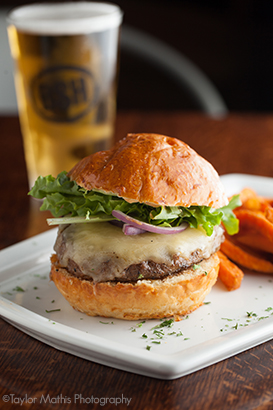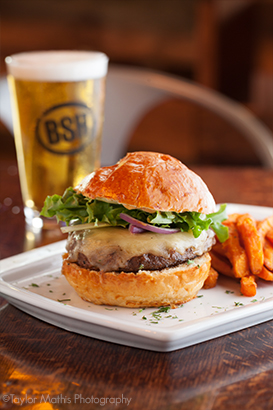Restaurant's interiors can be just as beautiful and recognizable as the dishes that they create. When shooting a dish, you may want to include some of a restaurant's interior elements in the shot. These can be chairs, walls, light fixtures, or anything else that shows off the restaurant's character. To do this, you will need to be able to balance the light you are creating with a flash and the ambient light in the restaurant. Here is a look at how I did this on a recent assignment involving a burger and beer.
If you are brand new to restaurant food photography, you will find this article, An Introduction To Restaurant Photography, very helpful. In the following shots, I am using the same artificial lighting set-up that I use in the article.

Above is a picture of a burger lit with artificial light. The burger is properly exposed with the shutter speed set at my camera's sync speed of 1/200 second. Generally, I like to shoot at this sync speed so I can work without a tripod and still have crisp sharp images. Inside the restaurant, it poses a problem. This fast shutter speed is too fast for the ambient light in the room to enter the picture. Only what is in the range of my flash will be illuminated. This creates a properly exposed subject and foreground with a very dark and underexposed background. There are times when a black background is what you are going for, but in this case I find it distracting. This is not what you would see if you were sitting down to dine. The solution is to put the camera on a tripod and decrease the shutter speed. I realize there are varying levels of photographers reading this, so this may be a repeat for some of you, but for some of you this may be new information. Your shutter speed will determine how much ambient light reaches your camera's sensor. A longer shutter speed will allow for more ambient light to reach your camera's sensor and increase the background's exposure.

Above is what happens when the shutter speed is decreased from 1/200 sec to 1/3 of a second. Notice how the burger looks the same in each picture, but the backgrounds of the images look completely different. In the image on the right, you can now see some of the restaurant's character and scenery! Here is what the final image shot at this shutter speed looks like.

At this slower shutter speed, the brighter, properly exposed background no longer distracts from the image. In a restaurant, there is something that you will need to pay attention to when increasing the shutter speed.

Increasing your shutter speed will let in more ambient light. This ambient light includes any overhead lighting that may be at your table. Take a look at the above areas circled in green. On the left the image was shot at the sync speed. On the right, the image was shot at a slower shutter speed. The bright circle that you see on the right is from an overhead ceiling light. These lights will leave spots on reflective table tops and can cause highlights on your food. They are usually a tungsten based or fluorescent light source. If most of your ambient light is daylight coming in from windows, then watch out for these additional light sources causing color shifts. If possible, I will ask the restaurant to turn off these lights, or move to a location where they won't be a problem.
Balancing the ambient light with the artificial light you are creating is a very simple thing that might get overlooked. If you are working with a one light set-up and don't want a distracting black background in your shot then this technique will be very helpful!
For more food photography tips and tutorials, check out issues 1-7 of photographing FOOD.











I got completely tripped up on the terminology used. Why would "increased" shutter speed let more ambient light through? It took me a while to realize that correct term should be "decreasing" the shutter speed. After all the jump from 1/200 second to 1/3 second is a decrease in speed, not an increase.
1/3 is greater than 1/200.
The higher the denominator (the bottom number) the smaller the portion. Think of it this way: a 1/2 cup measure is bigger than a 1/4 cup.
1/3 of a second is slower than 1/200 of a second. Thus the jump from 1/200 sec to 1/3 sec is a decrease in speed, not an increase in speed.
@David_Silverman, you are dead in correct. The terminology is at best misleading and at worst flat out wrong. "Increasing" the shutter speed is the speed by which the shutter opens and then closes. Opening and closing in an "increased" speed is letting in LESS light, the opposite of what this article is instructing readers to do.
You are absolutely correct. I made the same mistake as the author— thinking increase of light while actually talking shutter speed.
Thanks for catching that. You are correct that a decrease in shutter speed is an increase in exposure.
"Increasing your shutter speed will let in more ambient light."
Still needs to be fixed, I believe. Great post though!
1/3 second represents an increase in the exposure time over 1/200th, the same as 30 sec is an increase over 1 second. It's a bit goofy when dealing with the fractions and the concept of "increase of speed" (which means a decrease in exposure time).
Very cool article. You touched on something very important. It isn't ALWAYS just about "proper" exposure but also about context. Photography is multifaceted and endlessly fascinating because of it. Nice!
Why not just use a polarizer to remove that "overhead lighting" highlight rather than doing it later in post?
Effectiveness of a polarizer on the reflection will depend on the angle
at which the light hits the surface and the material properties of the
surface. Table overhead lights with a moderately high camera angle will
see, generally, little polarization. I usually find a gobo to block the
light before reflection to be better. Often, this is as simple as
holding the drink menu in front of the light. Either is better than doing it in post, though. :-)
For new comers you forgot to mention that you will have to also turn your flash way down otherwise your burger will be way over exposed.
Actually, once you have the proper exposure on the burger set wth your flash, decreasing the shutter speed won't change that at all. Decreasing shutter speed is only affecting the ambient light in the background and not the instantaneous flash on the burger. This is also something us event photographers utilize when deciding how much of the background we want in the shot or if we want it blacked out. Now if you increase your aperture size, then you'll have to adjust your flash or else the burger (or subject) would be over exposed, but if you are only changing the shutter speed, you don't have to dial down your flash.
Not 100% of the time, a slower shutter speed will allow more ambient light to hit the burger as well as the background.
The flash speed remains constant irrespective of the shutter speed. Meaning that in half a hundredth of a second, the flash would have already lit the burger bright enough that the ambient light would have to be severly overexposed in order to overshadow the work of the flash ('shadow' sure seems like the wrong word to use here :P).
With our sensors and film (most film I guess), light records over dark and not the other way round. Once a bright light has been recorded, a dimmer light cannot record over that bright light. That's the reason we can have multiple exposures of a moving light object over a dark background and not that of a moving dark object over a light background.
And that's the reason any film exposed to light was ruined and any shot made with the lens cap on could still be recorded over.
Chuckle ... while the basic idea is correct the main questions now becomes : I NEED A TRIPOD TO PULL THAT STUNT !!!
Tourists rarely tout a tripod while ambling through a city. And restaurant owners are not at all that happy when guests set up a tripod in a clamped region between tables.
I'm assuming this photo shoot is for a restaurant client. A tourist or a casual diner should NOT be using a flash in a restaurant without proper permission. It's just rude for all the other diners. If it's during business hours and you want to take a photo, I'd just suggest figuring out a way to shoot with a long exposure (prop your camera on a cup or something) and color correct for the ambient light. PLEASE don't use a flash or tripod.
When changing your shutter speed from 1/200 to 1/3 what about the sink speed of the camera? Mine is 1/200th. Also what about using gels with the flash to counter the ambient light?
You may get better results by taking a test shot of something around 18% gray and using color correction in your raw processor. In Adobe Camera Raw, it's a single click with an eye dropper tool to get perfect color temperature.
You realise the Sync speed only becomes an issue if going for a faster shutter speed, like 1/500th. 1/3 of a second exposure on a camera with a 1/200 sync speed isn't an issue at all.
As for colour corrections, gels work if you have just the one type of ambient light - in a mixed lighting situation (over head fluros and window light for eg) you need to start thinking about other options - or be very good with your equipment.
These situations are why pro's use something like a Colour Checker Passport on every shoot and in every setup.
Thank you! What was I thinking? (I was thinking in the wrong direction). Thanks for clarifying. I'll look into the Color Checker.
Also, very nice article.
thank you
nice shoot